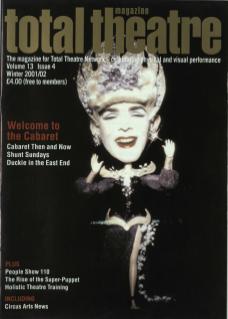An empty stage but not an empty space: Hoxton Hall's stage area – with its stairs, balconies and doorways – has an intrinsic dramaturgical power that makes anything that happens in it of interest, and it is a good decision to allow that space to establish itself before the performer enters. Then, a voice: or rather, two voices sharing the same body, a banging of doors; footsteps. Our host appears, taking his role of artist/shaman seriously, dressed in a motley mixture of furs and colourful rags with a Davy Crockett head-dress.
He is a host in the sense of Master of Ceremonies and in the religious sense of a vehicle of transubstantiation. Through him, the simplest of elements are transformed alchemically into theatre: a bit of jesting, some storytelling, a tune on the piano. He steps across the 'pit' to challenge the usually passive role of the audience. At this performance, the audience are expected to work hard, to stay in constant engagement with the performer, to realise that without this there will be no theatre as the text is to be created then and there by all those present.
Sometimes this works brilliantly – for example when we are coerced into applauding individual audience members ever more loudly – but at other times it falls flat. Picking a young woman from the audience, Kay throws away a golden opportunity by going down a predictable path of sexually stereotyped interaction. There are also times when Kay makes irritating assumptions about his audience's viewpoint or reactions – but knowing Kay he would have probably been delighted if one of us had had the courage to challenge him!

